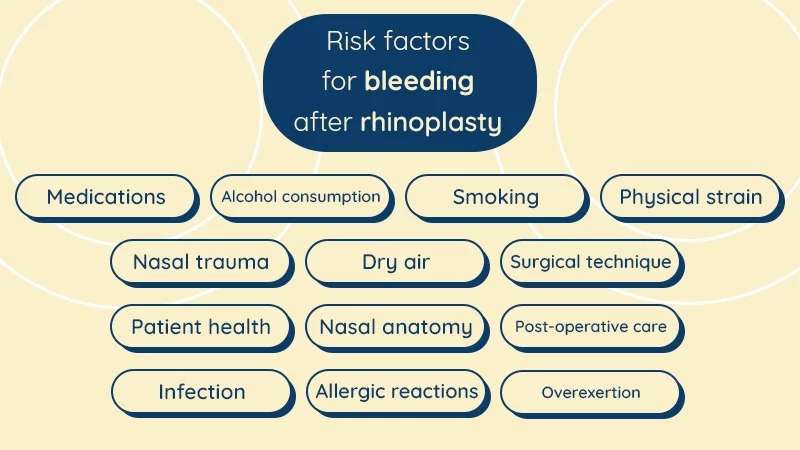Nosebleeds After Rhinoplasty: Causes and How To Manage Them
- ByMedical Content Team
- Medically Reviewed byDr. Sabine Kulhanek
Fact checked

- How normal is nose bleeding after a nose surgery?
- How long should nosebleeds after nose surgery last?
- Risk factors for bleeding after rhinoplasty
- Is it normal to have pinkish fluid discharge after nose surgery?
- How to prevent post-rhinoplasty nosebleeds?
- When to call my doctor?
- How to clean off dried blood after rhinoplasty?
Despite the transformative results that nose surgery or rhinoplasty can bring, post-operative risks and side effects such as bleeding are often an unavoidable part of the process. While the outcome of nose surgery is typically worth the temporary challenges, experiencing side effects is a common occurrence that patients should be prepared for and understand as part of the journey to achieving their desired aesthetic goals. Nosebleeds are one of the most common side effects that can be an unexpected and concerning occurrence for individuals undergoing rhinoplasty.
While nosebleeds post-rhinoplasty are relatively common, understanding the reasons behind their occurrence and learning effective management strategies are crucial for a smooth recovery journey. In this blog post, we’ll discuss the causes of nosebleeds after rhinoplasty and provide practical tips to help you navigate and alleviate this potential post-operative concern. Let's explore why nosebleeds happen after rhinoplasty and how you can effectively manage them to ensure a successful and comfortable recovery experience.
How normal is nose bleeding after a nose surgery?
Nosebleeds are relatively common after nose surgery, whether cosmetic rhinoplasty or septoplasty, which is due to the delicate nature of the nasal tissues and blood vessels. During rhinoplasty, the nasal tissues are manipulated and may become more sensitive, increasing the likelihood of bleeding. Factors such as trauma to the nasal passages, dryness, and the use of blood-thinning medications can also contribute to nosebleeds post-rhinoplasty. While experiencing some degree of nosebleeds is normal during the initial stages of rhinoplasty recovery, persistent or severe nosebleeds should be promptly addressed by your surgeon to rule out any complications and ensure proper management.

How long should nosebleeds after nose surgery last?
However, persistent or severe nosebleeds beyond the initial post-operative period may warrant further evaluation by your surgeon. If nosebleeds continue for an extended period, become more frequent or severe, or are accompanied by other concerning symptoms such as excessive swelling, pain, or fever, it is important to contact your surgeon promptly for assessment and appropriate management.
Overall, while some degree of nosebleeding after nose surgery is normal, the duration and severity of nosebleeds should be monitored closely, and any persistent or concerning symptoms should be promptly addressed by your healthcare provider.

Risk factors for bleeding after rhinoplasty
Certain factors can increase the risk of bleeding after rhinoplasty. By being aware of these factors and taking proactive measures to mitigate them, patients can help reduce the risk of bleeding after nose surgery and support a smoother recovery process Here are risk factors that can increase the risk of bleeding after rhinoplasty
- Medications: The use of blood-thinning medications including nonsteroidal anti-inflammatory drugs (NSAIDs) such as aspirin and ibuprofen, and herbal supplements like ginkgo biloba can increase the risk of bleeding post-rhinoplasty.
- Alcohol consumption: Alcohol consumption can thin the blood and increase the chances of bleeding. It is advisable to avoid alcohol in the days leading up to and following rhinoplasty.
- Smoking: Smoking can impair blood circulation and oxygen delivery to tissues, delaying the healing process and increasing the risk of bleeding complications after rhinoplasty.
- Physical strain: Engaging in strenuous activities, heavy lifting, or exercises that elevate blood pressure can put undue stress on the nasal area and potentially lead to bleeding.
- Nasal trauma: Any form of nasal trauma, such as bumping the nose or blowing it forcefully, can disrupt the delicate healing tissues and increase the risk of bleeding.
- Dry air: Dry air can cause nasal dryness and irritation, making the nasal passages more prone to bleeding. Using a humidifier can help maintain moisture levels and reduce this risk.
- Surgical technique: The extent and complexity of the nose surgery can impact the risk of bleeding, with more invasive surgeries potentially leading to increased bleeding.
- Patient health: Pre-existing medical conditions such as clotting disorders, hypertension, or a history of excessive bleeding may heighten the risk of post-operative bleeding.
- Nasal anatomy: Anatomical variations in nasal blood vessels or nasal septum deviations may predispose individuals to a higher risk of bleeding during or after rhinoplasty.
- Post-operative care: Inadequate post-operative care, such as excessive blowing of the nose, physical trauma, or failure to follow the surgeon's instructions, can contribute to bleeding episodes.
- Infection: Post-operative infections can lead to inflammation and tissue damage, increasing the likelihood of bleeding complications.
- Allergic reactions: Allergic reactions to medications or materials used during surgery can trigger inflammation and potentially contribute to bleeding issues.
- Overexertion: Engaging in strenuous activities or heavy lifting soon after your nose job procedure can elevate blood pressure and strain the nasal area, increasing the risk of bleeding after nose surgery.
By identifying and addressing these risk factors, surgeons can take necessary precautions to minimize the risk of nosebleeds after rhinoplasty and optimize patient outcomes. Patients can also play a proactive role by disclosing their medical history, following pre-operative guidelines, and adhering to post-operative care instructions to reduce the likelihood of bleeding complications.
Is it normal to have pinkish fluid discharge after nose surgery?
The pinkish fluid is typically a combination of blood and clear fluid that may drain from the nasal passages during the initial stages of the healing process. This discharge is a common occurrence post-surgery as a result of the manipulation of nasal tissues, blood vessel disruption, and the body's natural healing response.
The pinkish fluid discharge may continue for a few days to a week following nose surgery and is usually not a cause for alarm. However, if the discharge persists, becomes excessive, foul-smelling, or is accompanied by other concerning symptoms such as severe pain, fever, or increasing swelling, it is advisable to contact your surgeon for further evaluation and guidance. Monitoring the discharge and following your surgeon's post-operative care instructions can help ensure a smooth recovery process.
How to prevent post-rhinoplasty nosebleeds?
Experiencing nosebleeds after rhinoplasty is common due to the delicate nature of the nasal tissues post-surgery. Here are some effective tips to help prevent or stop post-rhinoplasty nosebleeds:
- Gentle nasal care: Avoid blowing your nose forcefully or picking at scabs to prevent trauma to the healing nasal tissues.
- Humidification: Use a humidifier in your room or try saline nasal sprays to keep nasal passages moist and reduce dryness that can lead to nosebleeds.
- Medication adjustment: Consult your surgeon about adjusting any medications that may increase the risk of bleeding.
- Avoiding irritants: Steer clear of irritants like smoke, strong odors, and pollutants that can aggravate the nasal passages and trigger nosebleeds.
- Head elevation: Keep your head elevated while resting to reduce blood flow to the nasal area and alleviate pressure.
- Cold compress: Applying a cold compress gently to the bridge of the nose can help constrict blood vessels and minimize bleeding.
- Stay hydrated: Drink plenty of fluids to maintain overall hydration, which can prevent dryness in the nasal passages.
- Contact your surgeon: If nosebleeds persist, worsen, or are accompanied by other concerning symptoms, contact your surgeon for further evaluation and guidance.
By following these tips and maintaining communication with your surgeon, you can effectively manage and reduce post-rhinoplasty nosebleeds for a smoother recovery experience.
Also Read: Do's and Don'ts After Rhinoplasty Surgery

When to call my doctor?
After rhinoplasty, it is essential to be vigilant about any signs of complications, especially if you notice blood in your nose. Here are some situations when you should consider calling your doctor after seeing blood in your nose post-surgery:
- Excessive bleeding: If you experience persistent or heavy bleeding that does not seem to be subsiding.
- Clots or dark blood: If you notice large clots or dark-colored blood in your nasal discharge.
- Increased pain: If you have a sudden increase in pain, particularly if it is accompanied by bleeding.
- Fever: If you develop a fever, as this could be a sign of infection.
- Persistent symptoms: If the bleeding persists beyond the expected timeframe or is accompanied by other concerning symptoms like severe swelling, redness, or difficulty breathing.
- Foul odor: If you notice a foul odor coming from your nose along with the bleeding.
- Concerns or questions: If you have any concerns or questions about the amount or frequency of bleeding you are experiencing.
It is important to communicate with your surgeon promptly if you have any of these symptoms or concerns after rhinoplasty, as they can assess the situation, provide guidance, and ensure appropriate management to promote a safe and successful recovery.
How to clean off dried blood after rhinoplasty?
Cleaning dried blood after a nose job surgery is a delicate process that should be done gently to avoid causing irritation or disrupting the healing process. Here are steps to effectively clean off dried blood post-surgery:
- Softening the blood: Moisten a clean cotton ball or gauze pad with saline solution or sterile water to gently soften the dried blood.
- Gentle removal: Carefully dab the moistened cotton ball or gauze pad on the dried blood to help loosen and remove it without causing additional trauma to the nasal area.
- Avoid scrubbing: Refrain from scrubbing or picking at the dried blood, as this can lead to irritation and disrupt the healing process.
- Repeat as needed: If the dried blood does not come off easily, continue to gently moisten and dab the area until the blood is removed.
- Nasal saline rinse: Your surgeon may recommend using a saline nasal rinse to help clean the nasal passages and remove any dried blood gently.
- Avoid harsh products: Avoid using harsh or abrasive cleansers, alcohol-based products, or tissues that may cause irritation to the sensitive nasal tissues.
By following these gentle cleaning steps and guidelines provided by your surgeon, you can effectively remove dried blood after rhinoplasty while promoting proper healing and minimizing the risk of complications. If you have any concerns or encounter difficulties with cleaning dried blood, contact your surgeon for further guidance and assistance.





